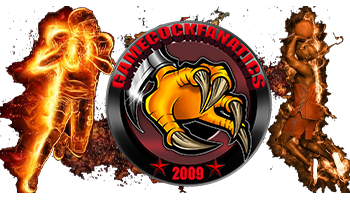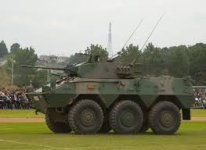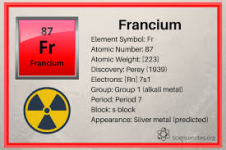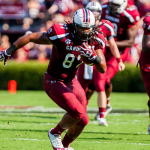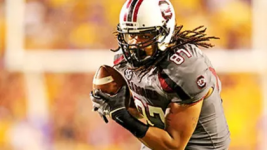Gamecock Fanatics
You are using an out of date browser. It may not display this or other websites correctly.
You should upgrade or use an alternative browser.
You should upgrade or use an alternative browser.
College Football Countdown: University of South Carolina
- Thread starter GregoryHouse
- Start date
Buddy Baker


| Driver | Races | Wins | Top 5's | Top 10's | Laps Led | Laps | Avg Finish | Avg Start | Poles |
| Buddy Baker | 123 | 0 | 18 | 43 | 182 | 26,254 | 17 | 17.2 | 0 |
Dale Jarrett

| Driver | Races | Wins | Top 5's | Top 10's | Laps Led | Laps | Avg Finish | Avg Start | Poles |
| Dale Jarrett | 380 | 28 | 129 | 188 | 6,074 | 109,290 | 14.5 | 16.9 | 15 |
Darrell Waltrip


| Driver | Races | Wins | Top 5's | Top 10's | Laps Led | Laps | Avg Finish | Avg Start | Poles |
| Darrell Waltrip | 161 | 26 | 82 | 97 | 7,949 | 47,895 | 11.9 | 5.4 | 18 |
Dale Earnhardt, Jr.

| Driver | Races | Wins | Top 5's | Top 10's | Laps Led | Laps | Avg Finish | Avg Start | Poles |
| Dale Earnhardt Jr. | 340 | 9 | 73 | 139 | 2,749 | 96,702 | 15.3 | 16.4 | 8 |
Bobby Allison


| Driver | Races | Wins | Top 5's | Top 10's | Laps Led | Laps | Avg Finish | Avg Start | Poles |
| Bobby Allison | 31 | 8 | 14 | 20 | 2,423 | 9,336 | 9.5 | 7.7 | 1 |
Kevin Harris' 88-yard TD run vs. Vanderbilt in 2020 in a game Carolina would win 41-7.
View: https://youtu.be/QOGyQH5zs6s
Last edited:
VF-88 was a U.S. Navy F6F Hellcat fighter squadron known as "The Gamecocks" that fought briefly in the final weeks of WW2 on board the aircraft carrier USS Yorktown (CV-10). It was disbanded in October 1945 and, for whatever the reason, never re-established in later years as some WW2 squadrons were.
Here is their squadron patch:

VF-88 was part of Carrier Air Group 88 (CVG-88) along with the Helldiver dive-bombers of VB-88 ("Gringos") and the Avenger torpedo bombers of VT-88 ("Tormentors"). VF-88 itself was formed sometime before June 1945 and shipped to the newly-captured island of Saipan following 3 months of training in Hawaii. It conducted carrier qualifications on the escort carrier USS Makassar Strait (CVE-91) before arriving on Yorktown in June 1945.
The VF-88 Gamecocks aboard the Yorktown in 1945. The enlisted fighter pilots are proudly wearing their distinctive white dixie cup hats. (below)
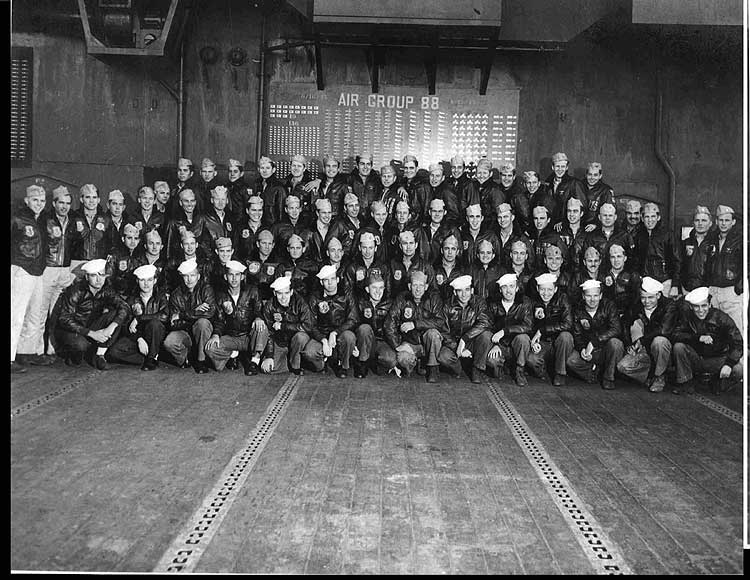
The VF-88 Gamecocks fought in one of the last major aerial engagements between Navy and Japanese fighters of WW2. Despite only being in theatre about two months, CVG-88 suffered heavy losses. One can infer from the narrative below just how bloody the invasion of Japan was anticipated to be at the time the atomic bombs were dropped. It might also explain why the Yorktown ended up in Charleston as a museum.
The official end of the war with the Japan occurred on 15 August 1945 when Japan officially accepted the terms of peace agreed to by the Allies in the Potsdam Declaration of 26 July 1945, which called on Japan to proclaim “unconditional surrender” or face “prompt and utter destruction” (although the declaration left ambiguous the emperor’s fate).
Up until then, Admiral Halsey’s naval assets had continued air strikes against the main islands of Japan until the terms were officially accepted by Japan to pressure the Japanese to accept the terms of surrender and end the bloodshed.
A 103-plane fighter sweep of airfields near Tokyo in advance of carrier airstrikes was scheduled to be launched at 0415 on 15 August 1945 followed by a bombing strike launch at 0530. Despite the atomic bombings on 8 and 9 August of respectively Hiroshima and Nagasaki, the Japanese had still not officially surrendered at the time the fighter and bomber attacks were launched. At 1449, 14 August, Tokyo time, Radio Tokyo had announced that an imperial rescript (statement) from Emperor Hirohito would be forthcoming soon, but no official word had yet been received at the time the strikes were launched of the carrier task forces.
Among those planes that launched on the morning of 15 August were twelve F6F Hellcats from the VF-88 “Gamecocks” aboard the USS Yorktown (CV-10). Despite having only rotated onto the Yorktown in June of 1945, Carrier Air Group 88 (CVG-88) had already suffered close to 20 percent in casualties, among them VF-88’s skipper, LCDR Dick Crommelin, who died in a mid-air collision in poor visibility on 13 July 1945. At the time of his death, Crommelin had two Navy Crosses from Coral Sea (where he had survived being shot down) and Midway, with 3.5 aerial kills.
In nine weeks aboard Yorktown, CVG-88 lost 14 pilots or aircrewmen: five from VF-88, six from VBF-88, and three from VB-88. Five CVG-88 pilots were lost during strikes in the Tokyo area on 10 July, and another seven were lost during the strikes on Kure Naval Base on 24 July, for 12 combat losses. Although the squadron leaders were veterans with combat experience, this was their first combat tour for the great majority of the pilots on CVG-88. So far, there had been no air-to-air combat for CVG-88.
On the morning of 15 August, Lieutenant Howard Harrison’s fighter team had not originally been scheduled for the mission. However, Harrison knew that Ensign Wright C. “Billy” Hobbs needed one more combat flight for a promotion to Lieutenant (j.g.), so he arranged a switch.
The mission for Harrison’s VF-88 Hellcats began to go bad almost from the start. They were supposed to join up with F4U Corsairs from carriers Shangri La (CV-38) and Wasp (CV-18), but within a few minutes after launch the VF-88 Hellcats ran into severe weather. Unable to go around or over, Harrison detached two Hellcats to orbit and provide communications relay as he took his remaining 10 aircraft down low under the weather. It was still a rough go, and somehow four of the Hellcats got lost in the clouds, leaving Harrison and five other Hellcats to continue toward the target at Atsugi.
At about 0610 Tokyo time, the U.S. government received Japan’s official acceptance of the terms of the Potsdam Declaration, relayed via the Swiss government. President Harry S. Truman called a press conference to make the announcement. At 0620, Fleet Admiral Nimitz sent an urgent message to Admiral Halsey stating that the Japanese had accepted the Potsdam Declaration terms. Halsey then received a transcript of Truman’s official peace announcement, later remembering thinking, “God be thanked. I’ll never have to order another man out to die.”
Vice Admiral McCain promptly cancelled the strikes and ordered the recall of those already in the air. When the aircraft got the word at about 0645, Harrisons’s Hellcats were already in sight of Atsugi and Commander Searcy’s strike was about 30 miles behind, still over water.
After hearing the recall order, Harrison led his group of Gamecock Hellcats in a loop around Atsugi, staying out of anti-aircraft gun range, and commenced a return to Yorktown. His pilots were about five miles outbound from Atsugi and experiencing the same sense of euphoria as Searcy’s strike (and all of TF 38’s airborne aircraft) when they were jumped from high and behind by a dozen or so Japanese fighters.
Accounts vary as to number (some say 15–20 Japanese aircraft) and type, but what is certain is that these were first-line aircraft flown by some of Japan’s best remaining pilots, apparently incensed about the word they had received about Japan’s surrender. It seems likely that there were eight Japanese Navy A6M Zero/Zeke fighters and four Mitsubishi J2M Raiden (“Lighting Bolt”) Jack fighters of the 302nd Kokutai (Air Group) at Atsugi.
(The Jack was a land-based, short-range, high-altitude Navy interceptor.) There may also have been Navy N1K-J Shiden George fighters involved, and some accounts indicate there may have been Japanese army aircraft (Ki-84 Franks) as well (these are possibly due to faulty identification in the heat of battle).
The six VF-88 Hellcats entered the air battle at a severe disadvantage, still weighed down by rockets and wing tanks they hadn’t had a chance to drop yet. They were outnumbered at least two to one, the Japanese had positional advantage at six o’clock high, and, except for Harrison, none of them had ever been in a dogfight before. Nevertheless, the 600 hours of flight training that U.S. Navy pilots had before reporting to the fleet initially paid off. Rear Admiral Radford subsequently wrote: “A wild fight ensued, the last important air battle of the war.” The after action report stated: “From then on it was a melee with everyone fighting in the same air.”
Harrison turned the flight to face the Japanese, and he and Hobbs veered after one pair of Japanese fighters while Mandeberg and Sahloff went after another pair. Within moments, four Japanese planes were going down in flames. The third pair of Hellcats, flown by Lieutenant (j.g.) Maurice “Maury” Proctor and Lieutenant (j.g.) Ted Hansen, engaged in a head-to-head pass with two Japanese fighters, hitting both; one attempted to ram Hansen.
Proctor then blew the wing off a third Japanese fighter, while other fighters made repeated passes on Hansen, which he jinked to avoid. By this time, Proctor and Hansen had lost track of the other Hellcats, when Proctor saw Sahloff’s Hellcat trailing smoke with a Japanese fighter on his tail. Proctor then shot up the Japanese fighter and radioed Sahloff to make for the ocean. Proctor intended to escort Sahloff, but a Japanese fighter got on his tail. Fortunately, this was shot down by Hansen. Proctor was then attacked by seven Japanese fighters. He managed to shoot one of them down and he would make it to Yorktown with 28 holes in his aircraft.
Sahloff was last seen weaving in and out of clouds before he had to bail out. One Hellcat exploded at 7,000 feet and two others were seen to fall in flames. Lieutenant Howard M. “Howdy” Harrison (who had survived a ditching in July), Ensign Wright C “Billy” Hobbs, Ensign Eugene “Mandy” Mandeberg, and Lieutenant (j.g.) Joseph G. Sahloff (who had survived the mid-air collision with Crommelin in July) did not return, did not survive, and were never found. After action reports claimed nine Japanese aircraft were shot down. While that number is probably too high, it was still a valiant fight against the odds—sadly, after the U.S. pilots thought they had made it through the war alive.
At 1055, Fleet Admiral Nimitz sent a message directing all offensive operations cease, but for all U.S. Navy forces to maintain an alert defensive posture. At 1100, Halsey’s flagship, battleship Missouri (BB-63), ran up her large battle flags, sounded her whistle and horn for one minute, and hoisted the signal “Well done,” followed by a speech by Halsey. However, there were still some Japanese aircraft that didn’t get the word or ignored the word.
Following the recall of the morning strikes, and mindful of Nimitz’s direction to maintain an alert defensive posture, Halsey issued an order to “investigate and shoot down all snoopers. Not vindictively but in a friendly sort of way.”
Within a few hours, U.S. aircraft shot down eight Japanese planes over water, four of them during Halsey’s victory speech. One Japanese D4Y Judy dive-bomber attempted to attack HMS Indefatigable, but was shot down by a pursuing Hancock F4U Corsair fighter. Parts of the plane landed on the Royal New Zealand Navy light cruiser HMNZS Gambia, whose anti-aircraft barrage was among the last shots of the war.
Here is the link that I summarized this info from.
https://www.history.navy.mil/conten...ectors-corner/h-grams/h-gram-051/h-051-1.html
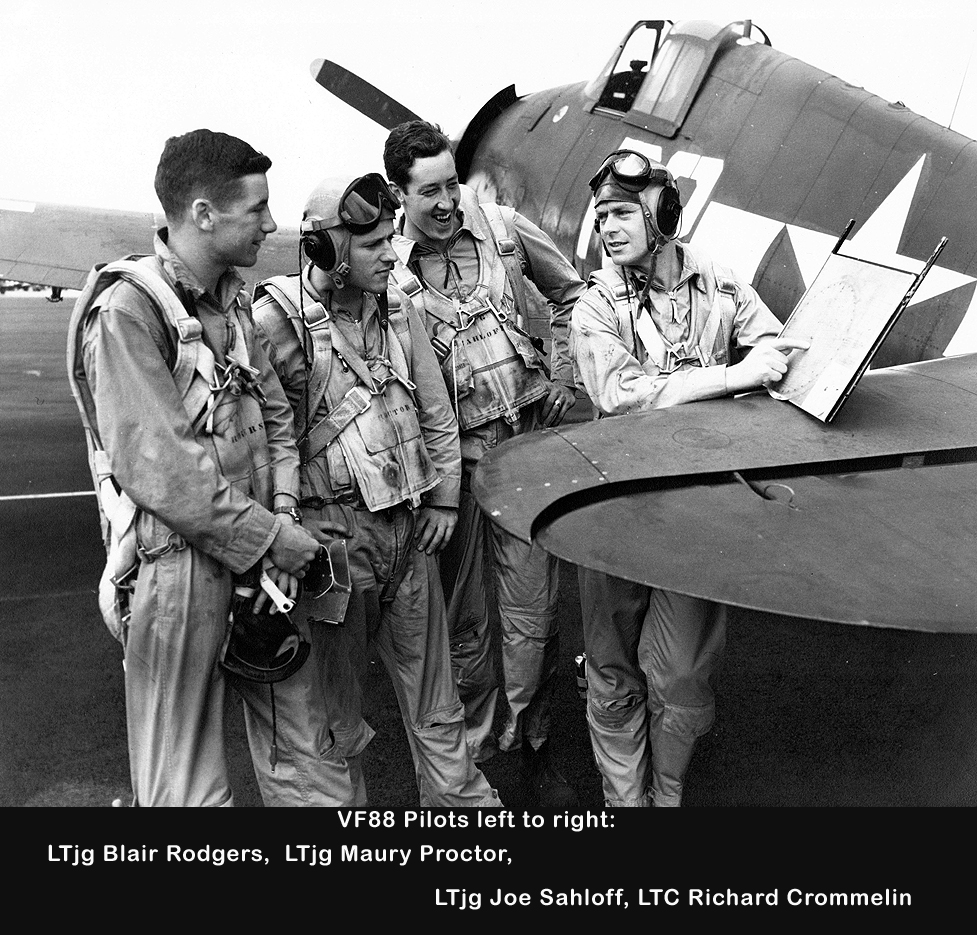
Joe Sahloff survived the mid-air collision in poor visibility that killed LCDR Crommelin in July 1945, but was shot down and killed in VF-88's first and last dogfight on 15 August 1945.
Maury Proctor was one of the two dogfight survivors who shot the video below with his 8mm movie camera and converted it to VHS in the 1990s to give to folks at VF-88's reunions.
View: https://www.youtube.com/watch?v=yo2eAEP5AAc
https://cv10.com/vf88/Index.htm
Proctor's video is a great companion to The Fighting Lady because it tells the story from the side of the everyday people who served on the ship. Blitzy will appreciate the slick ordnance elevator on the flight deck. The footage of the Gamecock Hellcats taking off down the left side of the flight deck while the center elevator is down is something I had never heard of before now. That's championship-level execution in anyone's book.
Here is another narrative of VF-88's dogfight.
In VF-88’s scant month of combat, the unit lost 10 aviators. For all of Air Group 88, including men lost during training, the tally was 31.
The newest Yorktown had deployed so recently that its airmen and sailors remained in the Pacific until October 1945. Only then did the Fighting Lady sail for San Francisco.
Departing the Bay months before, Herb Wood had resolutely ignored the crowds cheering from the iconic bridge spanning the Golden Gate.
This time, though, Wood was on deck, anticipating a welcome, only to realize that the homeland he had defended had made a far swifter transition to peace than he.
“When I returned, having lost all those buddies,” he said wistfully in a recent conversation, “there were only six people waving to us from the bridge.”
:quality(70)/arc-anglerfish-arc2-prod-mco.s3.amazonaws.com/public/O4HZEEFYRBBARFY5FLTOANI5ZY.jpg)
 www.navytimes.com
www.navytimes.com
Here is their squadron patch:
VF-88 was part of Carrier Air Group 88 (CVG-88) along with the Helldiver dive-bombers of VB-88 ("Gringos") and the Avenger torpedo bombers of VT-88 ("Tormentors"). VF-88 itself was formed sometime before June 1945 and shipped to the newly-captured island of Saipan following 3 months of training in Hawaii. It conducted carrier qualifications on the escort carrier USS Makassar Strait (CVE-91) before arriving on Yorktown in June 1945.
The VF-88 Gamecocks aboard the Yorktown in 1945. The enlisted fighter pilots are proudly wearing their distinctive white dixie cup hats. (below)

The VF-88 Gamecocks fought in one of the last major aerial engagements between Navy and Japanese fighters of WW2. Despite only being in theatre about two months, CVG-88 suffered heavy losses. One can infer from the narrative below just how bloody the invasion of Japan was anticipated to be at the time the atomic bombs were dropped. It might also explain why the Yorktown ended up in Charleston as a museum.
The official end of the war with the Japan occurred on 15 August 1945 when Japan officially accepted the terms of peace agreed to by the Allies in the Potsdam Declaration of 26 July 1945, which called on Japan to proclaim “unconditional surrender” or face “prompt and utter destruction” (although the declaration left ambiguous the emperor’s fate).
Up until then, Admiral Halsey’s naval assets had continued air strikes against the main islands of Japan until the terms were officially accepted by Japan to pressure the Japanese to accept the terms of surrender and end the bloodshed.
A 103-plane fighter sweep of airfields near Tokyo in advance of carrier airstrikes was scheduled to be launched at 0415 on 15 August 1945 followed by a bombing strike launch at 0530. Despite the atomic bombings on 8 and 9 August of respectively Hiroshima and Nagasaki, the Japanese had still not officially surrendered at the time the fighter and bomber attacks were launched. At 1449, 14 August, Tokyo time, Radio Tokyo had announced that an imperial rescript (statement) from Emperor Hirohito would be forthcoming soon, but no official word had yet been received at the time the strikes were launched of the carrier task forces.
Among those planes that launched on the morning of 15 August were twelve F6F Hellcats from the VF-88 “Gamecocks” aboard the USS Yorktown (CV-10). Despite having only rotated onto the Yorktown in June of 1945, Carrier Air Group 88 (CVG-88) had already suffered close to 20 percent in casualties, among them VF-88’s skipper, LCDR Dick Crommelin, who died in a mid-air collision in poor visibility on 13 July 1945. At the time of his death, Crommelin had two Navy Crosses from Coral Sea (where he had survived being shot down) and Midway, with 3.5 aerial kills.
In nine weeks aboard Yorktown, CVG-88 lost 14 pilots or aircrewmen: five from VF-88, six from VBF-88, and three from VB-88. Five CVG-88 pilots were lost during strikes in the Tokyo area on 10 July, and another seven were lost during the strikes on Kure Naval Base on 24 July, for 12 combat losses. Although the squadron leaders were veterans with combat experience, this was their first combat tour for the great majority of the pilots on CVG-88. So far, there had been no air-to-air combat for CVG-88.
On the morning of 15 August, Lieutenant Howard Harrison’s fighter team had not originally been scheduled for the mission. However, Harrison knew that Ensign Wright C. “Billy” Hobbs needed one more combat flight for a promotion to Lieutenant (j.g.), so he arranged a switch.
The mission for Harrison’s VF-88 Hellcats began to go bad almost from the start. They were supposed to join up with F4U Corsairs from carriers Shangri La (CV-38) and Wasp (CV-18), but within a few minutes after launch the VF-88 Hellcats ran into severe weather. Unable to go around or over, Harrison detached two Hellcats to orbit and provide communications relay as he took his remaining 10 aircraft down low under the weather. It was still a rough go, and somehow four of the Hellcats got lost in the clouds, leaving Harrison and five other Hellcats to continue toward the target at Atsugi.
At about 0610 Tokyo time, the U.S. government received Japan’s official acceptance of the terms of the Potsdam Declaration, relayed via the Swiss government. President Harry S. Truman called a press conference to make the announcement. At 0620, Fleet Admiral Nimitz sent an urgent message to Admiral Halsey stating that the Japanese had accepted the Potsdam Declaration terms. Halsey then received a transcript of Truman’s official peace announcement, later remembering thinking, “God be thanked. I’ll never have to order another man out to die.”
Vice Admiral McCain promptly cancelled the strikes and ordered the recall of those already in the air. When the aircraft got the word at about 0645, Harrisons’s Hellcats were already in sight of Atsugi and Commander Searcy’s strike was about 30 miles behind, still over water.
After hearing the recall order, Harrison led his group of Gamecock Hellcats in a loop around Atsugi, staying out of anti-aircraft gun range, and commenced a return to Yorktown. His pilots were about five miles outbound from Atsugi and experiencing the same sense of euphoria as Searcy’s strike (and all of TF 38’s airborne aircraft) when they were jumped from high and behind by a dozen or so Japanese fighters.
Accounts vary as to number (some say 15–20 Japanese aircraft) and type, but what is certain is that these were first-line aircraft flown by some of Japan’s best remaining pilots, apparently incensed about the word they had received about Japan’s surrender. It seems likely that there were eight Japanese Navy A6M Zero/Zeke fighters and four Mitsubishi J2M Raiden (“Lighting Bolt”) Jack fighters of the 302nd Kokutai (Air Group) at Atsugi.
(The Jack was a land-based, short-range, high-altitude Navy interceptor.) There may also have been Navy N1K-J Shiden George fighters involved, and some accounts indicate there may have been Japanese army aircraft (Ki-84 Franks) as well (these are possibly due to faulty identification in the heat of battle).
The six VF-88 Hellcats entered the air battle at a severe disadvantage, still weighed down by rockets and wing tanks they hadn’t had a chance to drop yet. They were outnumbered at least two to one, the Japanese had positional advantage at six o’clock high, and, except for Harrison, none of them had ever been in a dogfight before. Nevertheless, the 600 hours of flight training that U.S. Navy pilots had before reporting to the fleet initially paid off. Rear Admiral Radford subsequently wrote: “A wild fight ensued, the last important air battle of the war.” The after action report stated: “From then on it was a melee with everyone fighting in the same air.”
Harrison turned the flight to face the Japanese, and he and Hobbs veered after one pair of Japanese fighters while Mandeberg and Sahloff went after another pair. Within moments, four Japanese planes were going down in flames. The third pair of Hellcats, flown by Lieutenant (j.g.) Maurice “Maury” Proctor and Lieutenant (j.g.) Ted Hansen, engaged in a head-to-head pass with two Japanese fighters, hitting both; one attempted to ram Hansen.
Proctor then blew the wing off a third Japanese fighter, while other fighters made repeated passes on Hansen, which he jinked to avoid. By this time, Proctor and Hansen had lost track of the other Hellcats, when Proctor saw Sahloff’s Hellcat trailing smoke with a Japanese fighter on his tail. Proctor then shot up the Japanese fighter and radioed Sahloff to make for the ocean. Proctor intended to escort Sahloff, but a Japanese fighter got on his tail. Fortunately, this was shot down by Hansen. Proctor was then attacked by seven Japanese fighters. He managed to shoot one of them down and he would make it to Yorktown with 28 holes in his aircraft.
Sahloff was last seen weaving in and out of clouds before he had to bail out. One Hellcat exploded at 7,000 feet and two others were seen to fall in flames. Lieutenant Howard M. “Howdy” Harrison (who had survived a ditching in July), Ensign Wright C “Billy” Hobbs, Ensign Eugene “Mandy” Mandeberg, and Lieutenant (j.g.) Joseph G. Sahloff (who had survived the mid-air collision with Crommelin in July) did not return, did not survive, and were never found. After action reports claimed nine Japanese aircraft were shot down. While that number is probably too high, it was still a valiant fight against the odds—sadly, after the U.S. pilots thought they had made it through the war alive.
At 1055, Fleet Admiral Nimitz sent a message directing all offensive operations cease, but for all U.S. Navy forces to maintain an alert defensive posture. At 1100, Halsey’s flagship, battleship Missouri (BB-63), ran up her large battle flags, sounded her whistle and horn for one minute, and hoisted the signal “Well done,” followed by a speech by Halsey. However, there were still some Japanese aircraft that didn’t get the word or ignored the word.
Following the recall of the morning strikes, and mindful of Nimitz’s direction to maintain an alert defensive posture, Halsey issued an order to “investigate and shoot down all snoopers. Not vindictively but in a friendly sort of way.”
Within a few hours, U.S. aircraft shot down eight Japanese planes over water, four of them during Halsey’s victory speech. One Japanese D4Y Judy dive-bomber attempted to attack HMS Indefatigable, but was shot down by a pursuing Hancock F4U Corsair fighter. Parts of the plane landed on the Royal New Zealand Navy light cruiser HMNZS Gambia, whose anti-aircraft barrage was among the last shots of the war.
Here is the link that I summarized this info from.
https://www.history.navy.mil/conten...ectors-corner/h-grams/h-gram-051/h-051-1.html

Joe Sahloff survived the mid-air collision in poor visibility that killed LCDR Crommelin in July 1945, but was shot down and killed in VF-88's first and last dogfight on 15 August 1945.
Maury Proctor was one of the two dogfight survivors who shot the video below with his 8mm movie camera and converted it to VHS in the 1990s to give to folks at VF-88's reunions.
https://cv10.com/vf88/Index.htm
Proctor's video is a great companion to The Fighting Lady because it tells the story from the side of the everyday people who served on the ship. Blitzy will appreciate the slick ordnance elevator on the flight deck. The footage of the Gamecock Hellcats taking off down the left side of the flight deck while the center elevator is down is something I had never heard of before now. That's championship-level execution in anyone's book.
Here is another narrative of VF-88's dogfight.
In VF-88’s scant month of combat, the unit lost 10 aviators. For all of Air Group 88, including men lost during training, the tally was 31.
The newest Yorktown had deployed so recently that its airmen and sailors remained in the Pacific until October 1945. Only then did the Fighting Lady sail for San Francisco.
Departing the Bay months before, Herb Wood had resolutely ignored the crowds cheering from the iconic bridge spanning the Golden Gate.
This time, though, Wood was on deck, anticipating a welcome, only to realize that the homeland he had defended had made a far swifter transition to peace than he.
“When I returned, having lost all those buddies,” he said wistfully in a recent conversation, “there were only six people waving to us from the bridge.”
:quality(70)/arc-anglerfish-arc2-prod-mco.s3.amazonaws.com/public/O4HZEEFYRBBARFY5FLTOANI5ZY.jpg)
In the last hours of war, blood and heroism and irony and loss
World War II was clearly in its closing days — or was it?
Last edited:
The "Gamecock of Fighting-88" newsletter for the VF-88 Gamecocks Hellcat squadron that served on the USS Yorktown (CV-10) in WW2.



I could not but help think of the old hardcopy Gamecock newspaper at USC back in the day when I found this.



I could not but help think of the old hardcopy Gamecock newspaper at USC back in the day when I found this.
Last edited:
Very good plastic models of a VF-88 Gamecock Hellcat and Corsair.
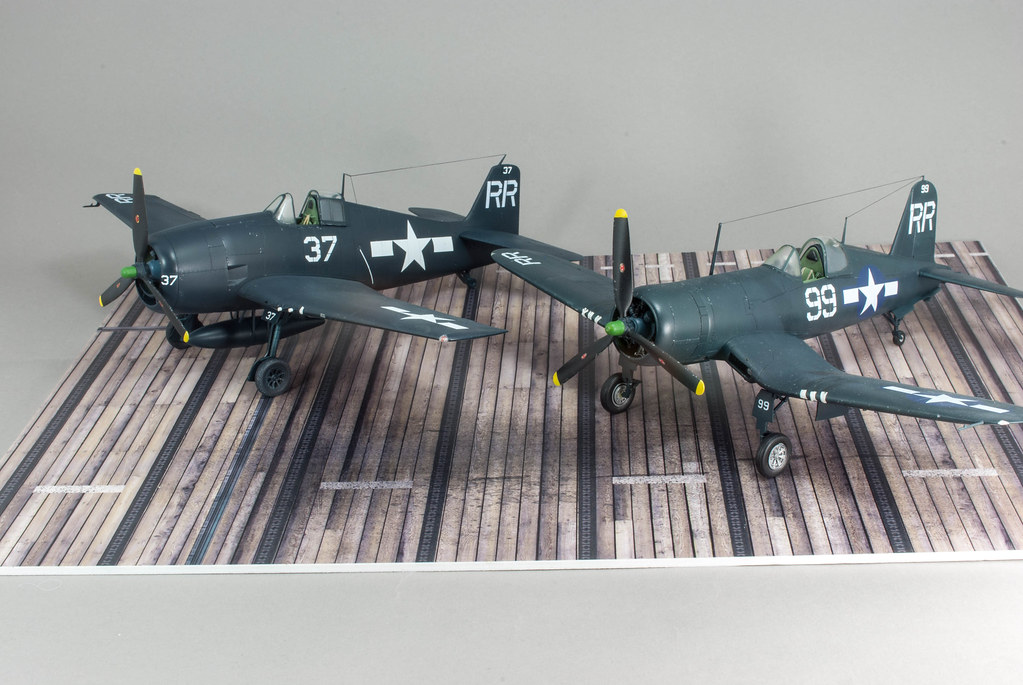



Last edited:

Dowdle: 87 yards and a touchdown in Gamecocks' win
Reynolds alum Rico Dowdle was critical to the South Carolina football team’s first win in more than a month.
The entrance to the 1987 Clemson game at W-B where the #7 Gamecocks defeated Clemson 20-7.
View: https://youtu.be/cSerToXBT4k
Highlights of the 1987 Gator Bowl in Jacksonville where #7 LSU defeated the #8 Gamecocks 30-13. We lost, but Top 10 is Top 10 and there are still some good looks at Morrison's team back then.
View: https://youtu.be/POxkTfGOk8s
Last edited:
Joe Nemechek



| Driver | Races | Wins | Top 5's | Top 10's | Laps Led | Laps | Avg Finish | Avg Start | Poles |
| Joe Nemechek | 222 | 0 | 1 | 6 | 14 | 31,270 | 35.3 | 30.4 | 0 |
Buck Baker







The man drove just about every car make there was and competed.
Sa-lute!!







| Driver | Races | Wins | Top 5's | Top 10's | Laps Led | Laps | Avg Finish | Avg Start | Poles |
| Buck Baker | 419 | 26 | 166 | 253 | 3,487 | 70,690 | 11.4 | 11.3 | 25 |
The man drove just about every car make there was and competed.
Sa-lute!!
Gamecock RB AJ Turner had 14 carries for 86 yards and one TD in Carolina's 15-9 win over the Vols at Rocky Top in 2017.
View: https://youtu.be/KV-aAFhnG6I
View: https://youtu.be/d8kWRtT3V4g
Agent 86

The late actor Don Adams, who died in September of 2005, was originally born Donald James Yarmy. He took the last name of his first wife in order to go to the head of audition lines that were usually done in alphabetical order.
Born Donald James Yarmy on April 13, 1923 (correct, despite frequently reported erroneous dates) in New York City to Irish-Hungarian parents, Adams prepared for a career as a commercial artist. He joined the U.S. Marines in the early days of World War II.

He saw combat in the invasion of Guadalcanal and after being wounded was the only survivor of his platoon. He contracted Blackwater Fever (which had a 90% mortality rate) after being shot and nearly died, remaining hospitalized in Wellington, New Zealand for more than a year. After his recovery he served as a drill instructor. HQMC Unit Diaries indicate he was a Prison Guard/GCM Prisoner Guard at US Disciplinary Barracks, Hart's Island, NY.
There is a bit of conflicting information about his service, since he never spoke about any of it like many combat vets. He did actually receive the Purple Heart and was a member of India Company, 3rd Battalion, 8th Marine Regiment. The 8th Marines were sent in to reinforce and relieve the 1st Marine Division halfway through the bloody 6-month Guadalcanal campaign and played a crucial role in the final push to drive the Japanese Army off the island for good in early 1943. Adams was one of the nearly 2800 Marines wounded on Guadalcanal. Although a lot of online information states he was only briefly in the battle, 2-3 months on Guadalcanal was a lifetime.
The 8th Marines left Guadalcanal late January of 1943 to regroup in New Zealand in preparation for the bloody Tarawa campaign while Adams was recovering in a Navy hospital there during the same time. From what I've seen online, Blackwater Fever causes the red blood cells to explode and release extra hemoglobin into the bloodstream, so that's pretty nasty stuff. Ironically contracting it may have spared Adams possible death on Tarawa if you stop to think about it.
It is said that Adams time as a drill instructor contributed to his distinctive choppy delivery on Get Smart years later.
The 8th Marines were stood down for the third time in their vaunted history last year due to DoD restructuring.
Sa-lute!!

The late actor Don Adams, who died in September of 2005, was originally born Donald James Yarmy. He took the last name of his first wife in order to go to the head of audition lines that were usually done in alphabetical order.
Born Donald James Yarmy on April 13, 1923 (correct, despite frequently reported erroneous dates) in New York City to Irish-Hungarian parents, Adams prepared for a career as a commercial artist. He joined the U.S. Marines in the early days of World War II.

He saw combat in the invasion of Guadalcanal and after being wounded was the only survivor of his platoon. He contracted Blackwater Fever (which had a 90% mortality rate) after being shot and nearly died, remaining hospitalized in Wellington, New Zealand for more than a year. After his recovery he served as a drill instructor. HQMC Unit Diaries indicate he was a Prison Guard/GCM Prisoner Guard at US Disciplinary Barracks, Hart's Island, NY.
Shadow box
Marines.Togetherweserved.com - Shadow Box Profile of Cpl Donald James Yarmy
marines.togetherweserved.com
There is a bit of conflicting information about his service, since he never spoke about any of it like many combat vets. He did actually receive the Purple Heart and was a member of India Company, 3rd Battalion, 8th Marine Regiment. The 8th Marines were sent in to reinforce and relieve the 1st Marine Division halfway through the bloody 6-month Guadalcanal campaign and played a crucial role in the final push to drive the Japanese Army off the island for good in early 1943. Adams was one of the nearly 2800 Marines wounded on Guadalcanal. Although a lot of online information states he was only briefly in the battle, 2-3 months on Guadalcanal was a lifetime.
The 8th Marines left Guadalcanal late January of 1943 to regroup in New Zealand in preparation for the bloody Tarawa campaign while Adams was recovering in a Navy hospital there during the same time. From what I've seen online, Blackwater Fever causes the red blood cells to explode and release extra hemoglobin into the bloodstream, so that's pretty nasty stuff. Ironically contracting it may have spared Adams possible death on Tarawa if you stop to think about it.
It is said that Adams time as a drill instructor contributed to his distinctive choppy delivery on Get Smart years later.
The 8th Marines were stood down for the third time in their vaunted history last year due to DoD restructuring.
Sa-lute!!
Last edited:
The #7 Gamecocks defeated Missouri 31-10 on Sept. 22, 2012, to improve to 4-0. Marcus Lattimore had 21 carries for 85 yards and two touchdowns and added 7 receptions for 60 yards for 145 all-purpose yards. With his first score of the day he became Carolina's all-time leader in career rushing touchdowns with a total of 32. He added to his record with a one-yard touchdown run with ten minutes left in the first half.
View: https://youtu.be/xIj8MrKGXvI
View: https://youtu.be/tk3QYhJzKPw
View: https://youtu.be/Sb9Ak85mqEo
Last edited:
